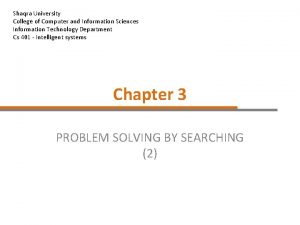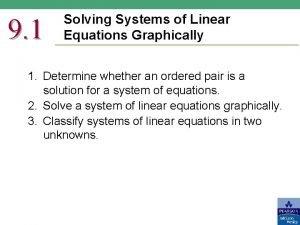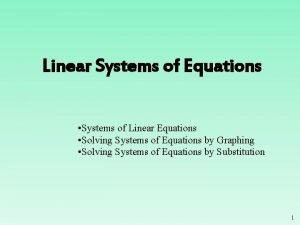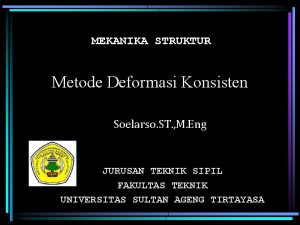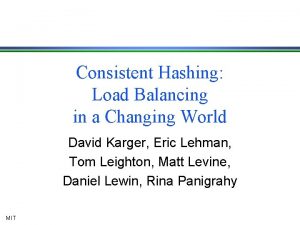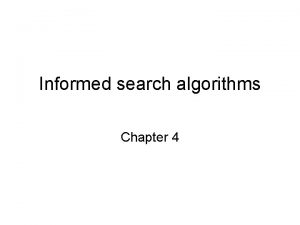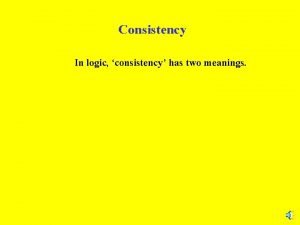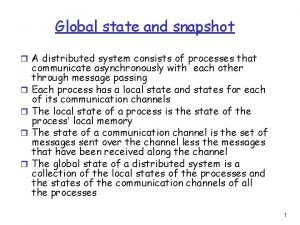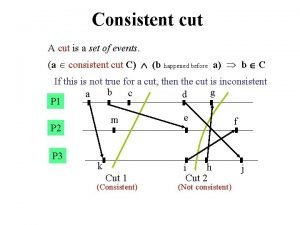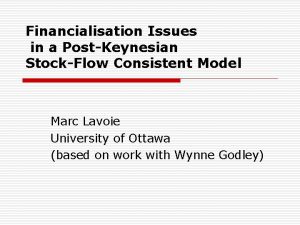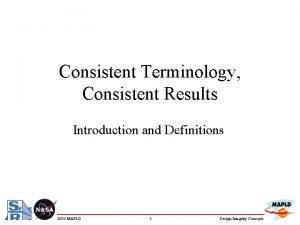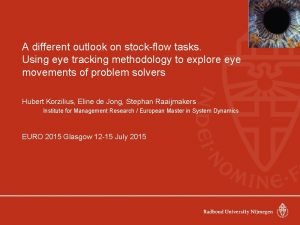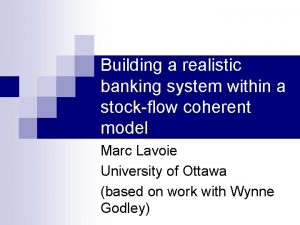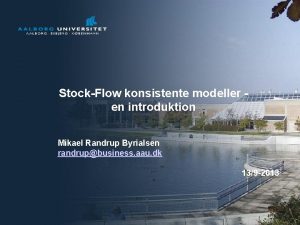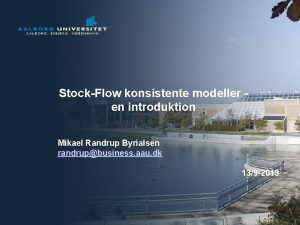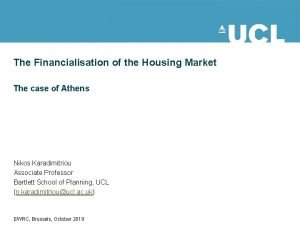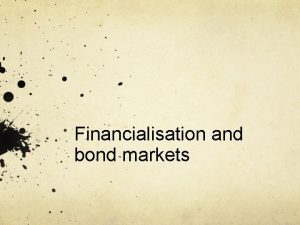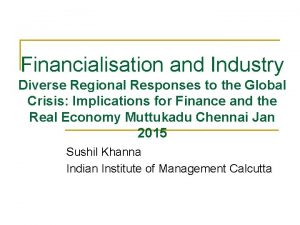Financialisation issues in a stockflow consistent approach Minsky

































- Slides: 33

Financialisation issues in a stock-flow consistent approach: Minsky and Godley Marc Lavoie

Problem statement • The current financial crisis, which started to unfold in August 2007, is a reminder that macroeconomics cannot ignore financial relations, otherwise financial crises cannot be explained. • Old Keynesians, with the exception of James Tobin and his followers, paid little attention to financial relations, besides the standard IS/LM model. • It was not always clear how Cambridge or Post. Keynesian economists did integrate financial relations in their real models.

American PK vs Cambridge PK • American PK (Minsky): Money, debt, liquidity, interest rates, cash flows – Fundamentalist PK – Financial Keynesianism – Wall Street Keynesianism • Cambridge PK: Real economy, actual and normal profit rates, pricing, rates of utilization – Robinsonians/Kaleckians – Kaldorians (Godley) – Sraffians

Minsky and Godley, 1970 s and 1980 s • Both authors wanted to go beyond standard Keynesianism, as represented either by the old neoclassical synthesis or represented by Cambridge PKs (also P. Davidson 1972). • We could say, as pointed out by Chick (1995, p. 33), that they both offered a response to the Monetarist critique, which claimed that Keynesianism concentrates too much on flows (except when discussing liquidity preference) and « did not properly incorporate money and financial variables » (Godley and Cripps 1983, p. 15). • They both wished to deny the claim, made by Kalecki (circa 1936), that « I have found what economics is; it is the science of confusing stocks with flows » !

Outline • Godley’s view of financial Keynesianism and the SFC approach • Minsky and the SFC approach • Some results arising from a SFC model that integrates real and financial features

GODLEY’S VIEWS AND SFC

Some views taken from chapters 1 and 2

Standard flow accounting matrix in macro: elementary NIPA + Sources of funds; – Uses of funds

Drawbacks of standard macro • • • What form does personal saving take? Where does personal saving go? Where does the finance for investment come from? How are government budget deficits financed? Which sector provides the counterparty to every transaction in assets? • Standard macro relies on the 1953 presentation of the UN system of national accounts (SNA). • But there has been a fully integrated SNA version since 1968 (revised in 1993)!

Transactions matrix: NIPA with flow-of-funds accounts

Features of the transaction matrix • All rows sum to zero (counterparties) • All columns sum to zero (budget constraint) • Everything comes from somewhere and everything goes somewhere: • There should be no « black holes » . • We have NIPA, flows of financial payments, flow changes in assets and liabilities. • The matrix can be made as complicated as needed. • The flow matrix, along with a revaluation matrix (capital gains and losses) must be linked to the stock matrix, to find the evolution of stocks.

A more realistic balance sheet + = Assets; ─ = Liabilities

The revaluation matrix

THE SFC APPROACH I • The three matrices (flows, stocks, revaluation) and their links (the stock-flow coherent (SFC) approach) help pin down the evolution of whole economic systems, which is what macroeconomics is. • The claim here is that stock-flow consistent models (SFC models), inspired in particular by the work of Wynne Godley, are the likely locus of some form of post-Keynesian consensus in macroeconomics, as it allows to entertain both monetary and real issues within a single model, by dealing both with tangible and financial capital.

THE SFC APPROACH II • The SFC approach is a response to the critics who, as reported by Chick (1995, p. 20), believe that PKE is « not coherent, not scientific, not formal, not logical » • « The fact that money stocks and flows must satisfy accounting identities in individual budgets and in an economy as a whole provide a fundamental law of macroeconomics, analogous to the principle of conservation of energy in physics » (Godley and Cripps 1983, p. 18). • SFC restrictions « remove many degrees of freedom from possible configurations of patterns of payments at the macro level, making tractable the task of constructing theories to close the accounts into complete models » (L. Taylor 2004, p. 2).

THE SFC APPROACH III • Two strands of research linking stocks and flows: – Godley and Cripps (1983) at Cambridge, • Cambridge Economic Policy Group, • New Cambridge school (1970’s). – Tobin (1982) and his associates at Yale, • the ‘pitfalls approach’ (1969) • the New Haven school. • Godley (1996, 1999) manages to combine elements of the two strands, mixing the portfolio adding-up conditions of Tobin to Keynesian behavioural equations. In particular, Godley has endogenous outputs.

MINSKY AND SFC

Minsky and SFC models I • “One way every economic unit can be characterized is by its portfolio: the set of tangible and financial assets it owns and the financial liabilities on which it owes” (Minsky 1975, p. 70). • « Inasmuch as the effective demand for current output by a sector is determined not only by the current income flows and current external finance but also by the sector’s cash-payment commitments due to past debt, the alternative interpretation can be summarized by a theory of the determination of the effective budget constraints. The economics of the determination of the budget constraints logically precedes and sets the stage for the economics of the selection of particular items of investment and consumption » (Minsky 1975, p. 132)

Minsky and SFC models II • “An ultimate reality in a capitalist economy is the set of interrelated balance sheets among the various units. Items in the balance sheet set up cash flows” (Minsky 1975, p. 118). • “To analyze how financial commitments affect the economy it is necessary to look at economic units in terms of their cash flows. The cash-flow approach looks at all units – be they households, corporations, state, and municipal governments, or even national governments – as if they were banks” (Minsky 1986, p. 221). • “The structure of an economic model that is relevant for a capitalist economy needs to include the interrelated balance sheets and income statements of the units of the economy. The principle of double entry bookeeping, where financial assets and liabilities on a balance sheet and where every entry on a balance sheet has a dual in another balance sheet, means that every transaction in assets requires four entries” (Minsky 1996, p. 77). • This is Morris Copeland’s (1949) quadruple entry principle.

Simplest example of the quadruple entry principle: a bank loan to firms

Other PK authors and flow-of-funds analysis: Eichner 1987 textbook • Eichner (1987, pp. 810 -838) devotes nearly 30 pages to flow-of-funds analysis in the chapter on money and credit of his main book, with more than a dozen tables reproducing flow-of-funds consequences of various decisions by economic agents. • The very first of these tables (Eichner 1987, p. 811) illustrates the quadruple accounting entry principle first put forth by Copeland, the US creator of flow-of-funds analysis. • Eichner “almost alone among economists – recognized that the flow-of-funds approach provides a much more useful analytical tool for explaining economic processes than the national income accounts”. Davidson (1992, p. 189)

Godley, Eichner and Minsky: Differences • Eichner thought that the monetary and financial systems were sufficiently resililient as long as the central bank did not pull the switch (Guttman 2010, Lavoie 2010). • Godley focused on a conditional theory based on a fair degree of stability in stock-flow norms. He argued that actual stock-flow ratios could not rise forever and that rising stock-flow norms would eventually lead to unsustainable processes, thus leading to required structural changes. • Minsky focused on the inherent instability of some stock-flow norms or of some liquidity and leverage norms, arguing that long periods of tranquillity would lead economic actors, and in particular banks, to let these norms deteriorate. • However, Minsky (1982, p. 30) also wrote that « consumer and housing debt can amplify … but cannot initiate a downturn in income and employment » .

An early interpretation of Minsky in terms of a SFC framework • It is interesting to note that the possible links between flow-of-funds analysis and balance sheet accounts on the one hand, and the Minskyan view of Wall Street economics on the other hand, were already underlined by Alan Roe (1973, EJ). • Roe argued that individuals and institutions generally follow stock-flow norms, but that during expansion they may agree to let standards deteriorate. He was also concerned with sudden shifts in portfolio holdings. • Roe explicitly refers to the work of Minsky on financial fragility, showing that a stock-flow consistent framework is certainly an ideal method to analyze the merits and the possible consequences of Minsky’s financial fragility hypothesis.

SOME FINANCIALISATION ISSUES IN A SFC MODEL (G&L 2007, CH. 11)

PK models that mix the real and the financial sides • Minsky-Kaleckian models (Taylor and O’Connell 1985; Semmler and Franke 1991), with a difference equation and portfolio equations • Non-linear Minsky models (Delli Gatti and Gallegati 1990 s; Jarsulic, Charles 2006, 2008) • Skott’s early SFC model 1981, 1988, 1989 • Palley’s model with consumer debt 1991, 1994 • Flaschel, Chiarella, Semmler 1990 s, 2000 s

Drawbacks of many previous models: Sometimes …. • • • Models are not fully stock-flow consistent Models do not incorporate growth Money is exogenous, or set by the government deficit The leverage ratio is not considered explictly There is no stock market, or, The stock market value of equities is determined by fundamentals, and not by market supply and demand

SFC models and financialization • Besides Lavoie and Godley (2001 -2) and Godley and Lavoie (2007, ch. 11), there are many more models, that can give rise to many other configurations • With government (Zezza and Dos Santos 2004, Dos Santos and Zezza 2008) • With different behavioural equations (Van Treeck 2009, Skott and Ryoo 2008, Clévenot 2007, Firmin 2008) • With the focus on banks (Le Héron and Mouakil 2008)

Main behavioural equations of the model the matrices of which was shown before: Households • Consumption on the basis of – past real wealth – current disposable income net of interest payments on loans, plus net additions to outstanding loans • Gross new loans is a fraction of personal income • Standard portfolio equations with adding-up conditions

Commercial banks • • Banks have own funds (net worth) Banks have retained earnings Banks make loans to firms and to consumers Have a bank liquidity ratio target range (bills/deposits) – Banks raise the deposit rate relative to the bills rate when the actual ratio is too low • Face a capital adequacy ratio requirement (BIS) – Banks raise the lending rate relative to the deposit rate when actual ratio is too low

Effect on the stock of personal loans of a one-time increase in the flow of gross household loans to personal income ratio G&L 2007

Effect of a one-time increase in the flow of gross household loans to personal income G&L 2007 (relative to baseline)

Evolution of the bank capital adequacy ratio and of the bank liquidity ratio, relative to the base line solution, following an increase in the gross new loans to personal income ratio

Evolution of the government deficit to GDP ratio and of the government debt to GDP ratio, relative to the base line solution, following an increase in the gross new loans to personal income ratio
 Kosky minski
Kosky minski Perceptron minsky
Perceptron minsky Society of mind marvin minsky
Society of mind marvin minsky Advantages of microscope
Advantages of microscope Traditional approach of development
Traditional approach of development Multiple approach-avoidance
Multiple approach-avoidance Deep learning approach and surface learning approach
Deep learning approach and surface learning approach Datagram network
Datagram network Bandura's reciprocal determinism
Bandura's reciprocal determinism Cognitive approach vs behavioral approach
Cognitive approach vs behavioral approach What is a research
What is a research Waterfall strategy marketing
Waterfall strategy marketing Best first search algorithm
Best first search algorithm One solution
One solution Structure of tenses
Structure of tenses What is a consistent verb tense
What is a consistent verb tense Linear system
Linear system The srs is said to be consistent if and only if
The srs is said to be consistent if and only if Metode konsisten deformasi
Metode konsisten deformasi Admissible and consistent heuristic example
Admissible and consistent heuristic example Consistent vs constant
Consistent vs constant Consistent hashing load balancing
Consistent hashing load balancing Search by image
Search by image Reliable vs consistent
Reliable vs consistent Consistency logic
Consistency logic What makes an equation dimensionally consistent
What makes an equation dimensionally consistent What is global state in distributed system
What is global state in distributed system Consistent follow up
Consistent follow up What is consistent cut?
What is consistent cut? Method of consistent deformation slideshare
Method of consistent deformation slideshare Consistent cut in distributed system
Consistent cut in distributed system Busqueda
Busqueda What is proportion in photography
What is proportion in photography Consistent verb mood
Consistent verb mood












